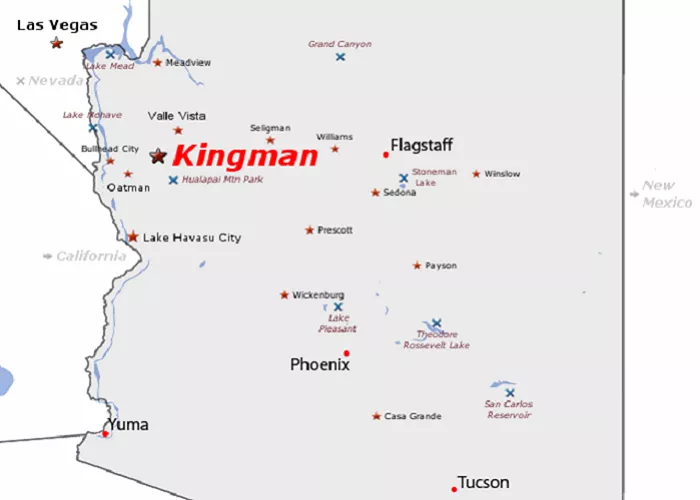Kingman, Arizona is a historic city located in the northwestern part of the state. Known as “The Heart of Historic Route 66,” Kingman offers a blend of rich history, scenic landscapes, and cultural attractions. This article explores Kingman’s geographical location, historical significance, and its role as a travel destination.
Geographical Location
Kingman is situated in Mohave County, in the northwestern region of Arizona. The city lies along Interstate 40 and U.S. Route 93, making it a key junction for travelers heading to destinations like Las Vegas, the Grand Canyon, and California.
- Coordinates: Approximately 35.1894° N latitude and 114.0530° W longitude.
- Elevation: About 3,333 feet (1,016 meters) above sea level.
- Nearby Landmarks: The city is near the Cerbat and Hualapai mountain ranges, providing scenic backdrops and outdoor recreational opportunities.
For a visual representation, refer to the USA Map to locate Kingman within Arizona and the broader United States.
Historical Significance
Kingman’s history is deeply intertwined with the development of the American West and the iconic Route 66.
- Railroad Origins: Established in 1882, Kingman began as a railroad town, serving as a hub for transportation and commerce in the region.
- Route 66: The city became a significant stop along Route 66, the “Mother Road,” which facilitated westward migration and travel during the 20th century.
- Mining and Ranching: The surrounding areas were rich in mineral resources, leading to mining booms that contributed to the city’s growth.
Kingman’s historical sites and museums preserve this rich heritage, offering insights into its past and the broader narrative of the American Southwest.
Transportation and Accessibility
Kingman’s strategic location makes it easily accessible by various modes of transportation.
- Roadways: The city is intersected by Interstate 40 and U.S. Route 93, providing direct routes to major cities like Las Vegas and Phoenix.
- Rail Services: Kingman is served by Amtrak’s Southwest Chief line, connecting it to cities across the country.
- Air Travel: While Kingman has a municipal airport, the nearest major airports are in Las Vegas and Phoenix, offering extensive domestic and international flights.
These transportation options make Kingman a convenient stop for travelers exploring the American Southwest.
Attractions and Points of Interest
Kingman boasts a variety of attractions that cater to history enthusiasts, nature lovers, and cultural explorers.
- Arizona Route 66 Museum: Located in the historic Powerhouse building, this museum showcases the history of Route 66 through exhibits and vintage memorabilia.
- Mohave Museum of History and Arts: This museum offers displays on local history, Native American artifacts, and art exhibits.
- Locomotive Park: Home to a historic steam locomotive, this park is a favorite for families and train enthusiasts.
- Hualapai Mountain Park: Just a short drive from the city, this park offers hiking trails, picnic areas, and cabins amidst pine forests.
- Historic Downtown: Kingman’s downtown area features preserved buildings, antique shops, and local eateries that reflect its rich heritage.
These attractions provide a glimpse into Kingman’s diverse offerings, making it a worthwhile destination for various interests.
Climate and Environment
Kingman experiences a semi-arid climate, characterized by hot summers and mild winters.
- Summer: Temperatures can reach up to 100°F (38°C), with low humidity levels.
- Winter: Mild temperatures averaging around 50°F (10°C), with occasional snowfall in higher elevations.
- Precipitation: The city receives an average annual rainfall of about 10 inches (254 mm).
The surrounding desert landscape and nearby mountain ranges offer diverse ecosystems, supporting various plant and animal species.
Community and Culture
Kingman’s community is known for its hospitality and cultural events that celebrate its heritage.
- Festivals: Events like the Route 66 Fun Run and the Kingman Street Drags attract visitors and locals alike.
- Arts and Music: Local galleries and music venues showcase regional talent and host performances throughout the year.
- Cuisine: The city’s dining scene includes classic American diners, Southwestern cuisine, and international options.
These cultural aspects contribute to Kingman’s unique identity and community spirit.
Conclusion
Kingman, Arizona, positioned in the northwestern part of the state, serves as a gateway to the American Southwest’s rich history and natural beauty. Its strategic location along major transportation routes, combined with its historical significance and cultural offerings, make it a compelling destination for travelers and history enthusiasts. Whether you’re exploring Route 66, delving into the region’s mining past, or enjoying the scenic landscapes, Kingman offers a multifaceted experience that reflects the spirit of the American West.

